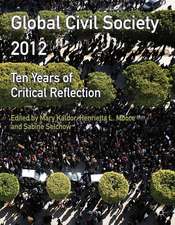The Economics of Killing: How the West Fuels War and Poverty in the Developing World
Autor Vijay Mehtaen Limba Engleză Paperback – 8 feb 2012
In this groundbreaking work, Vijay Mehta shows how attempts at peaceful national development are routinely blocked by Western powers. He locates the 2008 financial crisis in US attempts to block China's model of development. He shows how Europe and the US conspire with regional dictators to prevent countries from developing advanced industries, and how this system has fed terrorism.
Mehta argues that a different world is possible, based on policies of disarmament, demilitarisation and sustainable development. This original and thought-provoking book will be of great interest to anyone concerned about the consequences of endless war fuelled by the West.
| Toate formatele și edițiile | Preț | Express |
|---|---|---|
| Paperback (1) | 226.63 lei 6-8 săpt. | |
| PLUTO PRESS – 8 feb 2012 | 226.63 lei 6-8 săpt. | |
| Hardback (1) | 647.96 lei 6-8 săpt. | |
| PLUTO PRESS – 12 feb 2012 | 647.96 lei 6-8 săpt. |
Preț: 226.63 lei
Nou
Puncte Express: 340
Preț estimativ în valută:
43.36€ • 45.40$ • 35.88£
43.36€ • 45.40$ • 35.88£
Carte tipărită la comandă
Livrare economică 07-21 aprilie
Preluare comenzi: 021 569.72.76
Specificații
ISBN-13: 9780745332246
ISBN-10: 0745332242
Pagini: 248
Ilustrații: 1 figure
Dimensiuni: 135 x 215 x 18 mm
Greutate: 0.34 kg
Editura: PLUTO PRESS
Colecția Pluto Press
ISBN-10: 0745332242
Pagini: 248
Ilustrații: 1 figure
Dimensiuni: 135 x 215 x 18 mm
Greutate: 0.34 kg
Editura: PLUTO PRESS
Colecția Pluto Press
Notă biografică
Vijay Mehta is an author and peace activist. He is Chair of Uniting for Peace and founding trustee of the Fortune Forum charity. His books include The Fortune Forum Code: For a Sustainable Future (2006), Arms No More (2005), and The United Nations and Its Future in the 21st Century (2005).
Cuprins
Acknowledgement
Foreword
Introduction
Part I Military Industrial Complex – Power, Myths, Facts and Figures
1. How the West’s Addiction to Arms Sales Caused the 2008 Structural Financial Crisis
2. What is the Military Industrial Complex?
3. The Culture of Militarism and Global North’s Power of Definition
4. Europe and the Remaking of the Middle East
Part II Military Spending and Its Ill Effects
5. Negative Effects of Conflicts on Global, Human Security, Refugees, Forced Migrations and Urbanisation
6. War and its Ill Effects on Health, Environment and Development
Part III The Folly of Chronic Wars – For Profit, Resources and Domination – More Weapons – More Wars – More Profits
7. Terrorism and Non-State Actors, and How to Make Them Stop
8. China's Periphery – The Military-Industrial Mess That Could Destroy a Bright Future
9. The Emerging Conflicts – Other Future Fault-lines of the World
Part IV A New Vision, A New Beginning In A New Millennium – A Practical Way Of Reducing Arms, Armies And Wars For The Survival Of Humanity
10. Averting Disaster – What Type of Global Security Architecture Fits in Today’s World?
11. Replacing Military Industrial Complex – Making the 21st Century the Century of Soft Power
Epilogue: The Path Ahead
Notes
Index
Foreword
Introduction
Part I Military Industrial Complex – Power, Myths, Facts and Figures
1. How the West’s Addiction to Arms Sales Caused the 2008 Structural Financial Crisis
2. What is the Military Industrial Complex?
3. The Culture of Militarism and Global North’s Power of Definition
4. Europe and the Remaking of the Middle East
Part II Military Spending and Its Ill Effects
5. Negative Effects of Conflicts on Global, Human Security, Refugees, Forced Migrations and Urbanisation
6. War and its Ill Effects on Health, Environment and Development
Part III The Folly of Chronic Wars – For Profit, Resources and Domination – More Weapons – More Wars – More Profits
7. Terrorism and Non-State Actors, and How to Make Them Stop
8. China's Periphery – The Military-Industrial Mess That Could Destroy a Bright Future
9. The Emerging Conflicts – Other Future Fault-lines of the World
Part IV A New Vision, A New Beginning In A New Millennium – A Practical Way Of Reducing Arms, Armies And Wars For The Survival Of Humanity
10. Averting Disaster – What Type of Global Security Architecture Fits in Today’s World?
11. Replacing Military Industrial Complex – Making the 21st Century the Century of Soft Power
Epilogue: The Path Ahead
Notes
Index












